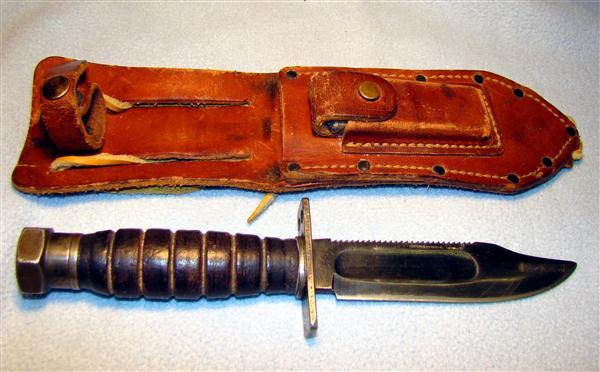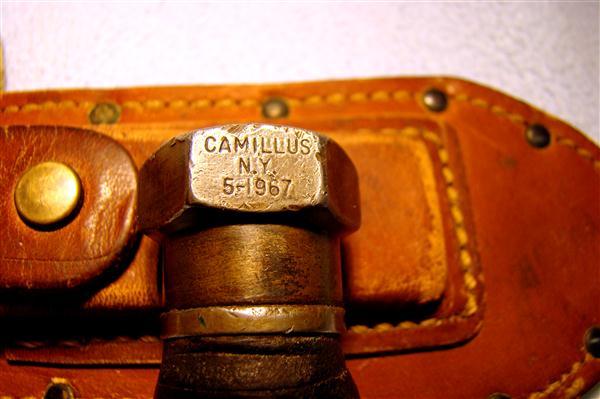-
American Helmet 'Time-Line'
Over the past six months or so, I decided to display my American helmets in a 'Time-Line' of when they would have been used. I boxed up many of my odd books and mostly just kept my reference books and some of the sets of books such as my Time-Life WWII books and Time-Life Aviation books, etc so I could have room to display my helmets that I had all over the place.
Here's a photo of all of them now. I have them displayed with the oldest on top and they go down from left to right on each shelf as they get newer, ending at the bottom with the newest.
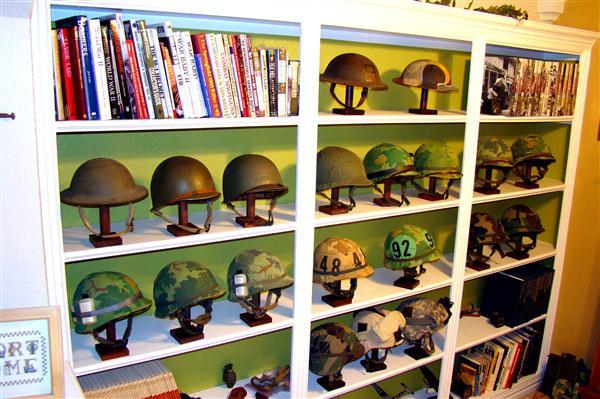
This is the top shelf, and these are two WWI vintage M-1917 helmets. They were a direct opy of the helmets the British wore in WWI. The helmet on the left is a 21st engineer attached to the 1st Army marked helmet. Engineers were not supposed to go to the front, but you know how the Army goes - This unit was one of the first American units to go to the trenches. (I have the full history and tunic of the original owner - He was wounded while at the front)
wore in WWI. The helmet on the left is a 21st engineer attached to the 1st Army marked helmet. Engineers were not supposed to go to the front, but you know how the Army goes - This unit was one of the first American units to go to the trenches. (I have the full history and tunic of the original owner - He was wounded while at the front)
The second helmet is what is known as a WWI 'Parade Helmet' -
The US Doughboys were fascinated with the brightly painted camo German helmets of WWI. The Doughboys were widely celebrated after they returned to the USA and they all went to parades - sometimes several parades and many annual parades. Most of them painted their divisional markings proudly on their helmets, and MANY painted them with outlandish colorful camo - This one has both the camo and 'X -Corp' painted on it.
and they all went to parades - sometimes several parades and many annual parades. Most of them painted their divisional markings proudly on their helmets, and MANY painted them with outlandish colorful camo - This one has both the camo and 'X -Corp' painted on it.
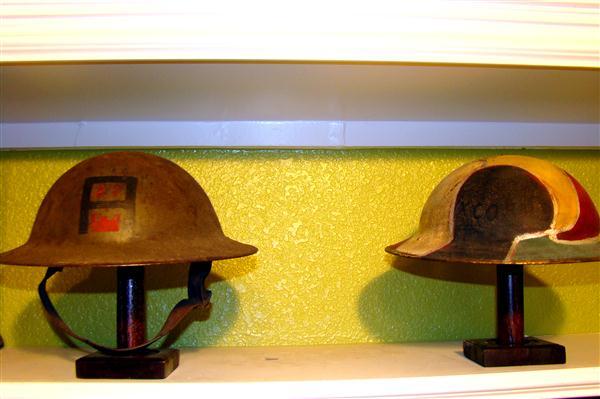
One shelf down starting from the left -
The helmet on the far left is a 1940 M-1917A1 helmet. It was derived from the WWI M-1917 but had a far better liner made from leather. They first started making this updated version sometime in the early 30's, and then upped production by 1940 as war seemed to be imminent. It also had a better chinstrap design that was carried over to the new M1. The later M-1 was under development, but this helmet was used as a 'stopgap' in the beginning of WWII, such as Pearl Harbor. It's also know by slang as a 'Kelly' and 'Bataan' helmet.
The middle helmet is an early WWII M-1 'Fixed Bale' due to the chinstrap loops not being flexible. The helmet on the right is a late WWII M-1 'Swivel Bale' - Among several other small changes, the swivel bales were used to preven the loops from breaking off like many of the fix bales did.
All the following helmets until the very bottom shelf are also M-1's from different periods. The M-1 design was used from 1941-1985
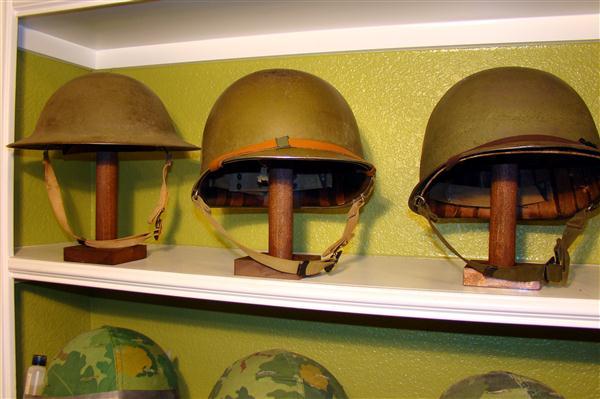
Left is a Korean War vintage helmet. It only differed slightly from WWII.
The middle and right are early 1962 Vietnam helmets and they're hard to find. Their suspension, etc was very close to the earlier WWII and Korean War with a few small changes.
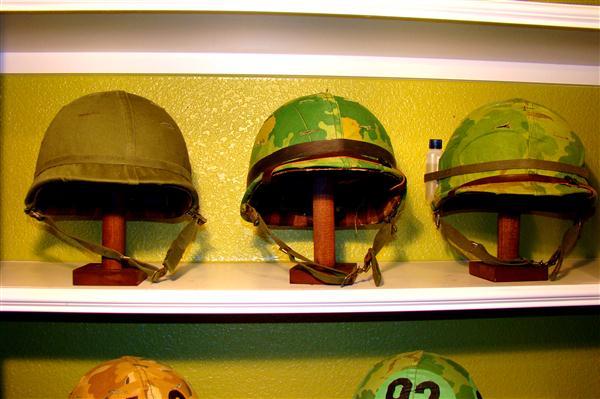
To their right are two very early M1-C helmets. The M1-C is the Paratroop version of the M1, and the M1-C designation was used for all paratroop types until the end of M1 helmet production. These are a 1961 and 1962. (They're very hard to come by)
The M1-C has a full chinstrap for the liners, as well as the helmet strap. It also has a small strap holding the liner and helmet shell together. All of this was done to try to keep the helmet together and also on the head when troopers left the plane and hit the vilonet slipstream.
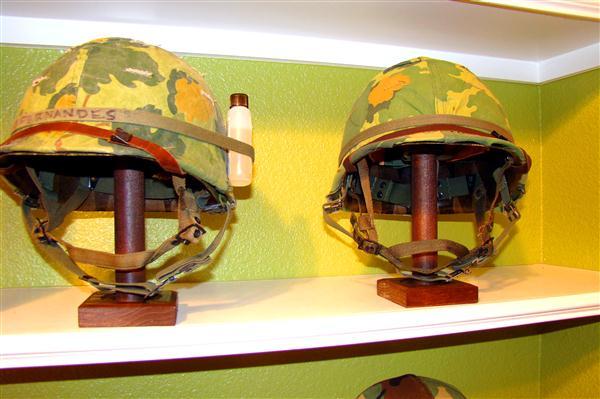
This is the start of the next shelf down, left side. The helmet on the far left is the later Vietnam M1. This design was used from 1964-1969. In 1964 they came out with an entirely upgrade liner. It had better suspension and it did away with the leather liner chinstrap that nobody used. The middle and right are M1-C's with the later design suspension the same as the helmet on the far left. Though not as rare as the earlier M1-C's, these are not exactly easy to find.
(The M1-C on the far right belongs to Jim (BAR) and the pride of my collection!)
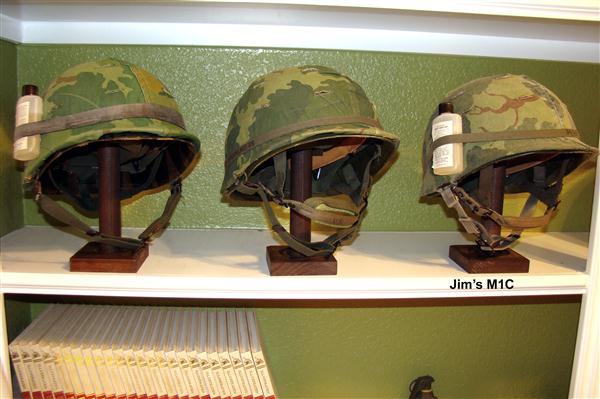
The middle shelf has two very unusual M1-C's that were numbered and used for training. There are very few of these, and when I found them I bought both of them. One is displayed with the brown side out, and the other green side out.
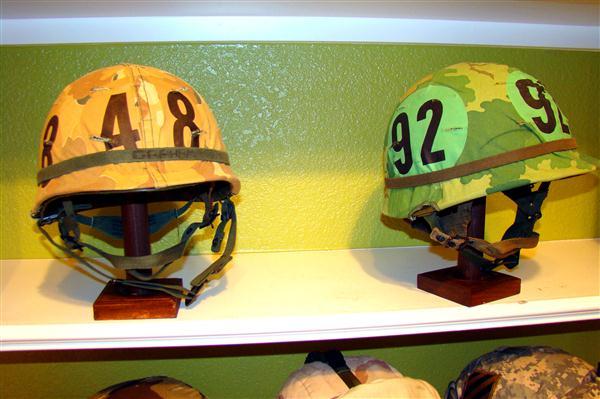
The last on the right are two post Vietnam War helmets, and the very last design of the M1 helmet lineage that was used through the Cold War period. The left is a 'Ground Troop' and the right is an M1-C.
Besides changing the covers to 'Woodland' camo, they completely redesigned the Ground Troop liner. The suspension was removable so it could be replaced - Liners had always worn out long before the bodies (Shells) and this was supposed to help. The M1-C on the right used a design all it's own. (These are hard to find too)
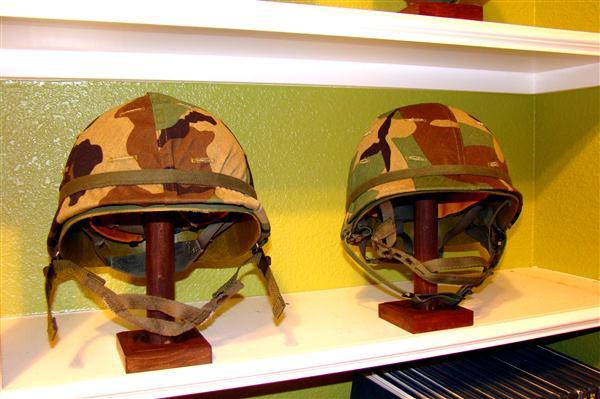
These are the very last helmets I have, and they are the Kevlar Type helmets that replaced the manganese steel M1 helmet in 1985.
The helmet on the far left is from the Cold War period and it's called a PASGT. This one was made in 1991 and has the 'Woodland' camo the same as the last M1's above. This camo was used to blend into the forests of Germany where they expected the Russian
where they expected the Russian hordes to come barreling through. The middle helmet is from 2001 and also a PASGT. It has one of the earlier desert camo covers. It has the night vision mount and dust goggles.
hordes to come barreling through. The middle helmet is from 2001 and also a PASGT. It has one of the earlier desert camo covers. It has the night vision mount and dust goggles.
The helmet on the right is the most current American helmet. It's called the 'ACH' for Advanced Combat Helmet. They raised the sides slightly and shortened the bill slightly on request from GI's. Doing so greatly helped out with vision. It has the modern digital camo and the full 'Rhino' arm for attaching night vision. It also uses a soft cushion liner that replaced the web suspension of the earlier PASGT. (It's similar to the liner in a motorcycle helmet) - It also uses a four point strap to keep it from moving forward and aft. I think it's miles above any of the helmets before it. This one was made in 2005.
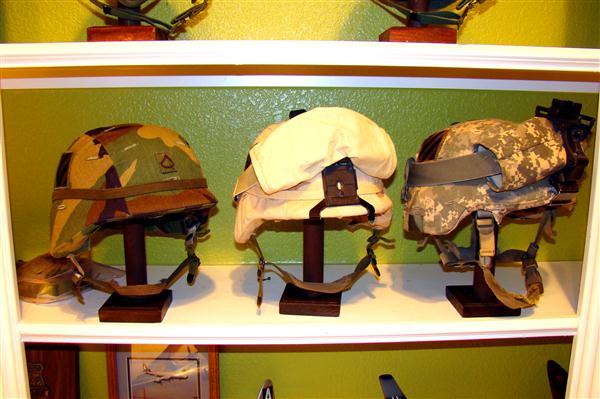
I know from just looking at the photos here all the M-1 helmets look alike, but they're actually very much different. It's also difficult to find liners that match the vintage of the shells - there was a lot of mixing and matching, upgrading, etc, just as was done to weapons. It's great fun searching, and then exciting when you find a helmet with all matching parts - You also have to do a LOT of reading BEFORE-hand just as you have to do with guns. Often the small things are hard to see, but mean a great deal.
Information
 |
Warning: This is a relatively older thread
This discussion is older than 360 days. Some information contained in it may no longer be current. |
|
Last edited by Harlan (Deceased); 06-06-2012 at 09:26 PM.
Reason: Added writing under Jim's helmet
-
The Following 13 Members Say Thank You to Harlan (Deceased) For This Useful Post:
ArizonaBeagle,
AZPhil,
blazer91,
Bob K,
conec,
HOOKED ON HISTORY,
JimF4M1s (Deceased),
jmoore,
Larry D.,
nzl1a1collector,
RCEMERalf,
Sarge1998,
topaz
-
06-05-2012 11:41 PM
# ADS
Friends and Sponsors

-
Legacy Member

Thanks. First I get hooked on collecting rifles which led to bayonets, and after seeing your display,helments. I only have two (my granfather's from WWII PTO and a brother in law's Vietnam era) so lots of holes.
Thank you for sharing your fine collection and the knowledge as well.
-
Thank You to HOOKED ON HISTORY For This Useful Post:
-
Thank you, 'Hook on History'. Now maybe you're 'Hooked on Helmets' too! 
You already have a good start. WWII helmets are the most expensive of all. The other helmets aren't so expensive, and a lot of fun to collect. Even WWI helmets aren't very expensive if you want one that just has it's original green paint and sawdust texture. You can often find unit painted WWI helmets for $100-$150 or so.
-
-
Legacy Member

Have been evilbaying a bit. I will start by trying to replace the long lost chin strap on the WWII model and probably get carried away after that. I also need a WWI campaign hat to display my other grandfather's hat cord. The leather strap across the front serves what purpose? To hold the liner in the shell?
PS the mosquito dope is a nice touch!
-
-
If you're talking about the leather strap on the front of M1 helmets, it just became a popular thing to do. It was the chinstrap for the liner when the liner was worn alone. They wore liners alone more than most people realize, and the liner chinstrap was supposed to help keep the liner on. Helmets were heavy, so when they were in rear areas they often just wore the liner - It offered some protection like a hardhat does. When in the field they did put the liner strap around the front just to get it out of the way, and it did help to keep the liner and shell together. Some just unhooked the liner chinstrap and threw it away. (They were very unpopular, and didn't have much of a purpose - In liners made after 1963, they did away with the liner chinstraps completely)
helmets, it just became a popular thing to do. It was the chinstrap for the liner when the liner was worn alone. They wore liners alone more than most people realize, and the liner chinstrap was supposed to help keep the liner on. Helmets were heavy, so when they were in rear areas they often just wore the liner - It offered some protection like a hardhat does. When in the field they did put the liner strap around the front just to get it out of the way, and it did help to keep the liner and shell together. Some just unhooked the liner chinstrap and threw it away. (They were very unpopular, and didn't have much of a purpose - In liners made after 1963, they did away with the liner chinstraps completely)
Many put the helmet strap around the rear of the shell to keep it out of the way.
(Some of it was just beause it was a 'Popular' thing to do - These were mostly kids, and they often did things like others were doing like young people always do)
There was a rumor that passed through the ranks that if there was a nearby explosion and the helmet chinstrap was worn, the concussion would break the wearer's neck, so most didn't wear their chinstraps. (The rumor was just that - a rumor with no truth behind it) - Later they came out with a ball and hook buckle that was supposed to break free if the helmet shell got hit. Partially they did it to get the GI's to wear the chinstrap - the helmet actually offered superior protection if the chinstrap was worn. The little piece to upgrade the buckle could be added to any of the older buckles, and the heavier buckle could also still be worn if the wearer wanted to.
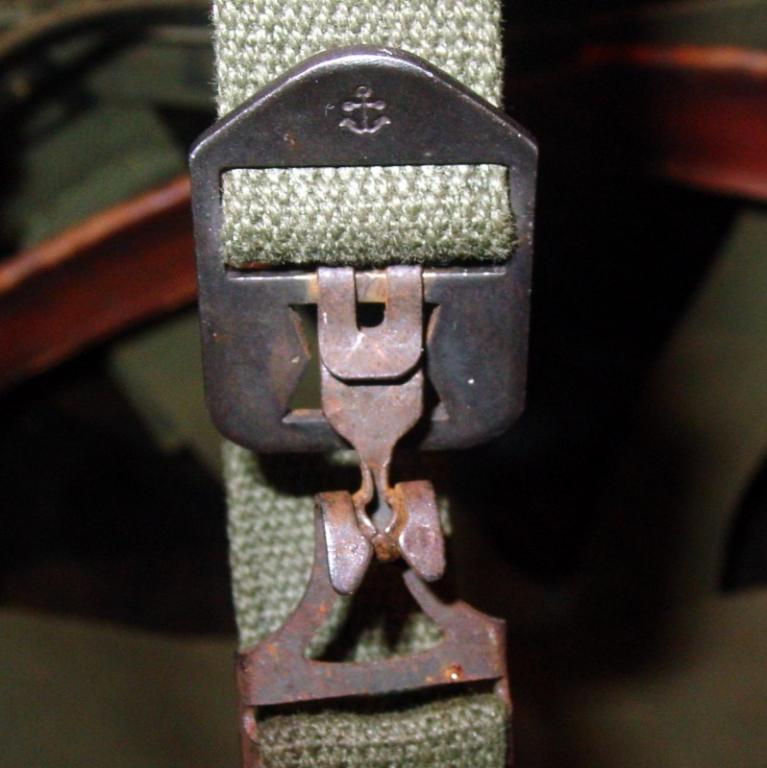
The anchor stamp came out in the Korean War and was widely used in Vietnam. It was only a manufacturer's logo, and it had nothing to do with the Navy, as some people will tell you. The 'anchor' was only referring to how well the buckle anchored to each other.
The rumor about breaking necks and soldiers wearing the chinstrap on the rear of the helmet seems to be more prevalent in the ETO. In period photos from the Pacific you see more Marines and many have the chinstrap buckled or just dangling when not in combat.
-
The Following 2 Members Say Thank You to Harlan (Deceased) For This Useful Post:
-
PS -
I just wanted to let you know if you want a WWII vintage liner chinstrap, they sell for over $100, and sometimes much over $100. As I said above, many were thrown away, and those that survived have gotten rotten and break very easily. Their insane prices just began to rise in the last six months or so - I think it's just supply and demand, or just perceived supply and demand - just a few months ago you could find complete WWII liners that still had chinstraps and they would sell for less than $100. Besides the price, the other downside is almost all of them are very delicate now.
Helmet collectors who own some of the high-end M1 helmets pay some outlandish prices to get an original liner chinstrap. (Many of the rare unit painted helmets ect, sell for $1500 up to $3000 and more, so paying $100 for an original liner strap is 'small beans')
helmets pay some outlandish prices to get an original liner chinstrap. (Many of the rare unit painted helmets ect, sell for $1500 up to $3000 and more, so paying $100 for an original liner strap is 'small beans')
They make reproductions that are fairly close to originals, so you need to be careful of any that are being sold as original. I leave the high-end original straps for the high-end collectors. I've been using liner straps that were manufactured in 1962. They're USGI so they're high quality, strong, and they look almost identical to the straps used in WWII. You should be able to find one of these for around $10 - $15.
-
-
-
The Following 3 Members Say Thank You to Harlan (Deceased) For This Useful Post:
-
Legacy Member

BEAUTIFUL! Thank you for the detailed information. I have a picture of Grandad in a fox hole in the Phillipenes with a buddy with helments in place. I think I will replace what ever straps are in place in the photo and display the helment and photo side by side.
-
-
FREE MEMBER
NO Posting or PM's Allowed

outstanding! thanks for the schoolin
-
FREE MEMBER
NO Posting or PM's Allowed

That is a GREAT display, well done. I've worked as a registrar and curator in museums and you've done a fine job with your presentation I've seen far worse done by "professionals"... Kudos!
wore in WWI. The helmet on the left is a 21st engineer attached to the 1st Army marked helmet. Engineers were not supposed to go to the front, but you know how the Army goes - This unit was one of the first American units to go to the trenches. (I have the full history and tunic of the original owner - He was wounded while at the front)
and they all went to parades - sometimes several parades and many annual parades. Most of them painted their divisional markings proudly on their helmets, and MANY painted them with outlandish colorful camo - This one has both the camo and 'X -Corp' painted on it.
where they expected the Russian
hordes to come barreling through. The middle helmet is from 2001 and also a PASGT. It has one of the earlier desert camo covers. It has the night vision mount and dust goggles.



























 Register To Reply
Register To Reply








